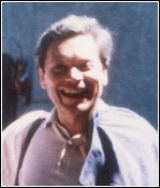
Eduard Melkus
Encyclopedia

Violin
The violin is a string instrument, usually with four strings tuned in perfect fifths. It is the smallest, highest-pitched member of the violin family of string instruments, which includes the viola and cello....
ist and violist
Viola
The viola is a bowed string instrument. It is the middle voice of the violin family, between the violin and the cello.- Form :The viola is similar in material and construction to the violin. A full-size viola's body is between and longer than the body of a full-size violin , with an average...
.
Following the Second World War, Melkus dedicated himself to the exploration of historically informed performance
Historically informed performance
Historically informed performance is an approach in the performance of music and theater. Within this approach, the performance adheres to state-of-the-art knowledge of the aesthetic criteria of the period in which the music or theatre work was conceived...
. He was a member of the 1949 Vienna viola da gamba quartet, the select group of musicians that included Alice and Nikolaus Harnoncourt
Nikolaus Harnoncourt
Nikolaus Harnoncourt is an Austrian conductor, particularly known for his historically informed performances of music from the Classical era and earlier. Starting out as a classical cellist, he founded his own period instrument ensemble in the 1950s, and became a pioneer of the Early Music movement...
and the harpsichordist Gustav Leonhardt
Gustav Leonhardt
Gustav Leonhardt is a highly renowned Dutch keyboard player, conductor, musicologist, teacher and editor. Leonhardt has been a leading figure in the movement to perform music on period instruments...
who started the Early Music movement.
He performed and recorded more than 200 works from the mid 17th through the late 18th centuries with his ensemble Capella Academica Wien, or the French harpsichordist Huguette Dreyfus
Huguette Dreyfus
Huguette Dreyfus is a French harpsichordist born on November 30, 1928 in Mulhouse, Alsace, France.-Biography:Huguette Dreyfus began taking piano lessons at four years old. In 1946, she began working with renowned piano teacher Lazare Lévy...
, and in his time, tapped a worldwide audience.
From 1958, Melkus was a professor of violin, baroque violin, viola, and historical performance practice at the Vienna Academy of Music. In 1982 he became head of the Institute for Viennese Sound Style.
As a violin soloist, Eduard Melkus is a precursor to the current wave in the revival of historically informed baroque period performance. His best-known recordings include Deutsche Grammophon
Deutsche Grammophon
Deutsche Grammophon is a German classical record label which was the foundation of the future corporation to be known as PolyGram. It is now part of Universal Music Group since its acquisition and absorption of PolyGram in 1999, and it is also UMG's oldest active label...
LPs of the Corelli Violin Sonatas, Opus 5 with rare extant 18th-century embellishments, prepared in conjunction with musicologist Marc Pincherele, the Biber Rosary Sonatas--for which he won the Deutscher Schallplattenpreis
Deutscher Schallplattenpreis
The Deutscher Schallplattenpreis was a prize that the Deutsche Phono-Akademie awarded from 1963 through 1992. Its successor is the ECHO prize....
in 1967, Tartini/Nardini Violin Concerti, the LP Hoheschule der Violine which includes the first period-instrument performances of the Tomasso Vitali Chaconne and Tartini Devil's Trill Sonata, and the Violin Sonatas, Opus 1 of G.F. Handel, the Bach Violin Concerti, Tartini/Nardini Violin Concerti, Couperin Apotheoses/Leclair Tombeau sonata, and an important LP entitled Polish and Hanakian Folk Music in the Work of G.P. Telemann. For all these recordings, Melkus played an unaltered violin by Aegidius Kloz, made in Mittenwald
Mittenwald
Mittenwald is a German municipality in the district of Garmisch-Partenkirchen, in Bavaria.-Geography:Mittenwald is located approx. 16 kilometers to the south-east of Garmisch-Partenkirchen...
ca. 1760, while the rest of his ensemble, the Cappella Academica Wien, played on far more expensive Italian instruments borrowed from the Vienna Akademie fur Musik and restored to resemble their original conditions. Melkus' later recordings of such works as Bach's Sonatas for Violin and Harpsichord were made on a retrofitted violin by Nicolo Amati
Nicolò Amati
Niccolò Amati was an Italian luthier from Cremona.-Biography:Nicolò Amati was the fifth son of Girolamo Amati and the grandson of Andrea Amati, the founder of the Amati Family of violin makers. Of all the Amati Family violins, those of Nicolò are often considered most suitable for modern playing...
of Cremona in 1679; though a richer-sounding and historically more important instrument, Melkus always sounded more daring and comfortable on the Kloz. Moreover, as Melkus always pointed out in liner notes, the Kloz is rare in that it survived with its original neck, bass-bar, and fingerboard, rather than requiring somewhat speculative retrofitting--which cannot be said for the Amati, and no Amatis survive in original state for restorer consultation. Melkus owns three other instruments by Nicolo Amati, comprising a complete string quartet by that unequalled maker.
Melkus is not much remembered today (2008) because his style included many anachronistic elements: the use of modern wire and wire-covered strings rather than gut, ubiquitous modern a1=440 pitch, a chin-rest (not even invented until the 1820s), and continuous, rather distracting, vibrato. In these ways, he departed from those better-known colleagues in Vienna with whom he began, the Harnoncourts. Oddly, he never adapted to methods that have been shown by scholars as more appropriate historically, even more recently. His older recordings are generally dismissed and have not been reissued on CD. It is a pity because, despite his less "authentic" sound, the recordings of the 1965-1971 period reveal in his playing what is lacking in most players today: an instantly recognizable personal sound and style, and most significantly, an enthusiasm for embellishing music in ways that more contemporary period players seldom attempt, but their 18th-century forbears did without question; in that sense, he is more "historical" than they--and to some listeners, more exciting.

